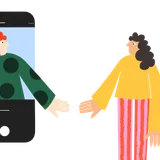
Business to Business is sexy Business – Find out Why
B2B communication is B2C’s ugly brother. As designers, we tend to disregard the opportunities a B2B client can bring. But B2B companies need to become brands. And in this shift designers can play a central role.
Are you going to miss the ride?
‘Order or chaos. Peace or war.’ The voice-over speaks in a whisper while on the screen the brutal mayhem of battle unfolds. You could think it’s Saturday afternoon at the movies, or Thursday evening at a slick fashion brand’s catwalk. As a matter of fact it’s Tuesday morning, and the occasion is an IT business-to-business presentation. The company is Oylo, an IoT cybersecurity firm whose target audience is white-collar executives from big industrial corporations.
B2B companies didn’t use to be sexy. Most of them still aren’t and might even view cold, rationale-based positioning as still desirable. We could argue that the term ‘companies’ is a good fit for B2B whereas B2C firms are better referred to as ‘brands’. Maybe the deliberate detachment of professionalism has something to do with it. Or the idea that decisions must be guided by reason rather than gut instinct. The trust that has to be placed on a large-scale buy and the high stakes in play could also affect how B2B companies present themselves. In any case the result is that B2B communication is often, at best, detached and impersonal if not downright dry.
B2B communication is usually detached, impersonal and dry. But a change is coming.
I think we are witnessing a shift in this kind of approach. And I want to present the case for a more human and compelling approach to communication for businesses which are aiming at other businesses, much like B2C behaves. B2B brands can and should be sexy. Here’s why.
Emotion sells
Emotion sells because emotion makes people connect. Emotions are a trait humans developed thousands and thousands of years ago to ensure the survival of the species. We all experience them and they help us make sense of the world. It comes as no surprise that brand communication tries to understand brand values in order to appeal to the emotions of a any given audience. But, at a business communication level, the construction of emotional narratives is all too often overlooked. The truth of the matter is that controlling the emotional factor is key to any relevant communication strategy. Lose this ingredient and you lose the essential element in any seduction strategy. Slowly but surely, emotions have become central to communication, and have even surpassed rational arguments. Coca-Cola exemplifies this journey to the heart of the consumer: below to the left is a 1950s ad with the rationale: reasons to buy Coca-Cola. To the right, a recent ad with the Coca-Cola dream expressed where the sole argument is an emotional one: do you want to feel like this?

Humans in the driving seat
CEO’s, buying directors and company executives are all human beings. As such, to a certain extent, they are driven by emotions. Of course they will still consider the rational reasons why they should pick a certain product or work with a certain partner. They are professionals after all and accountable for their decisions. And factors like personal relationships might affect their choices as much as economic or practical ones. But their emotions will be right there with them every step of the way.
On top of this, in their role as citizens and consumers they are exposed to, and interact with, all kinds of B2C communication in which the emotional appeal is thoroughly exploited. Deciding on business acquisitions and awarding contracts is part of their day to day work but the rest of the time they are just regular consumers. As such they are also affected by the presence of emotion in most of the communication they encounter.
CEOs and executives are all human beings driven by emotions, like anybody else.
And so, their buy is as emotional as any other buy. Their decision-making process to hire this or that consultant or this or that service will start emotionally, be processed emotionally and have an emotional outcome. Reason and other factors will interact with emotions during the individual thinking process of any given executive. This interaction will also be present in their conversations with colleagues on this matter. And in the end they will go with the best rational option possible. Coincidentally it will also be the one they like the most. Surprise, surprise!
Tom is the CEO of an automation developer. He needs to partner up with a manufacturer of IoT products. He has different offers on the table. The value for money one. The high performance one. The close relationship one. Then along comes Zigbee Alliance and their DotDot language to connect smart objects. They have a cool product range with complete capabilities. They fit his specs. They are not cheap but their presentations are fresh and sharp, and their numbers are spot on. The fact that their products look so cool just adds up to a general perception. Getting these guys is not only the right move, heck, it will make him look smart too! How much of this decision is based solely on reason? And what role did emotions play for Tom to be seduced by Zigbee?

Dress code: Informal
On top of all this we are seeing a certain return to informality. It is in our working habits. It is in the start-up culture. An executive worth millions might look like a teenage kid. It is in email language which has evolved a long way from the formalities of writing letters. It is in social networks, in how we consume content and in how we broadcast our lives. This return to informality is paving the way for less strict business interactions and consequently, for more space for creativity in business-to-business communication.
You think B2B isn’t worth it? Think again
I have a feeling that design studios have traditionally neglected the business-to-business client. If an industrial manufacturer, a financial consultant or a processing engineer knocks on our door, we are likely to see them but with some reluctance. We will work for them, no doubt, but the word ‘Boring!!’ will be flashing in big, bold letters across the back of our minds. It is a reasonable concern. Most B2B companies have largely overlooked and underestimated design. Consequently they haven’t introduced it into their corporate culture. Most B2B projects look dull, uninteresting or cold and they lack any trace of human empathy or emotion. But B2B companies are reaching out to designers. We would be wrong to disappoint them for a number of reasons.
As designers, we are wrong to neglect B2B companies reaching out to us. They are invaluable clients.
The most important one is opportunity. The role of design and communication within B2B companies is starting to change. It used to be just the superficial level of decoration that only came in at the end of the process. Now, it is the insightful methodology that can reshape a whole corporate culture. Today, the purpose of design is to highlight value. The opportunity lies in the novelty of this role. The fact that B2B companies are rediscovering design adds to the fact that they still haven’t quite incorporated it, and their comprehension of it is somewhat limited. One might recall the shining light of Paul Rand and his classic work for IBM and Olivetti. His contribution was incredible not only for the quality of his design, but more importantly because his is a rare example. There were some others, but they were few. For the most part business-directed communication has maintained its professional, cold and detached feel. Today, needs combines with a lack of understanding to present a clear demand. It is now possible to do things in B2B communication that just weren’t possible some years ago. This is an opportunity. It is a creative one for sure, but it is also a value one.
Good Business
Good design is good business. Corporations are understanding this now and so they will support creativity. They can provide the resources to make it possible. They can give it time to work. They will be happy to put money into it. In this context the designer comes in as an expert, as a consultant, as a partner. Corporations respect the designer for the expert that he is. The privilege that this position affords is one that we would be stupid to neglect.
Many B2B companies are involved in manufacturing or industrial processes; in knowledge processes; in R&D processes. These are all expensive. The volume of their operations is big. Compared to them, design budgets are relatively small and affordable. Taking into account what they bring they are good value for money. It’s for this very reason that B2B companies may even allocate to design the budgets they seldom have before. Not only to design processes, but also to the production processes that are the result of design propositions. This kind of investment is the energy that communication deserves; the support design needs to thrive and become good. And precisely because of this, Business Brands may enjoy the fruits of this support.

Symptoms of change. T(r)ending towards BTC
It is encouraging to witness the symptoms of this trend. Born from B2C roots, branded content has rocked B2B communication hard. Business brands have started using commercial film destined for their websites and social media platforms. Examples of this are Deloitte’s approach to cybersecurity. IBM has generated a film studio called IBM Films. B2B companies see the need to become B2B brands through creative identities or actions. Linde’s Sound of Fascinating Gases is an exciting show of such efforts. Technical and computational information is being conveyed through intricate CGI motion graphics. There are even many instances of visual design being brought in as technical help for engineering or scientific R&D processes.
Business Brands will invest in creativity. This is energy design can thrive on.
Briefs directed at design companies and advertising agencies used to draw a clear line; one that could not be crossed. This is a B2B company. This is a B2C company. This typical (and superficial) distinction is beginning to blur. B2B companies need to become brands. They need to become sexy. They need to be seductive; aspirational; emotional; human. Just like B2C brands, they need to understand their fundamental purpose and generate brand narratives. Business brands are a fiction as much as any B2C company, and they need to create corporate intersubjective realities worth buying into. They want to tap into the emotional triggers that move the executives who buy their services. This kind of brand ‘behaviour’ is close to that of B2C efforts. And Business brands are t(r)ending towards them.
The presentation is over. It’s been an hour, but it felt like 10 minutes. After all the dull conferences by the big old firms, Oylo has been a refreshment. Their message is innovative, challenging and strong. They are talking about stuff nobody else is. And they are doing it with cool graphics and flashing CGI movies. Right now, the buying decision is between this boring technical engineer, or that hacker James Bond guy over there. Who will the executive choose, I wonder…
Words by Marc Català, Partner & Creative Director at Mucho.


